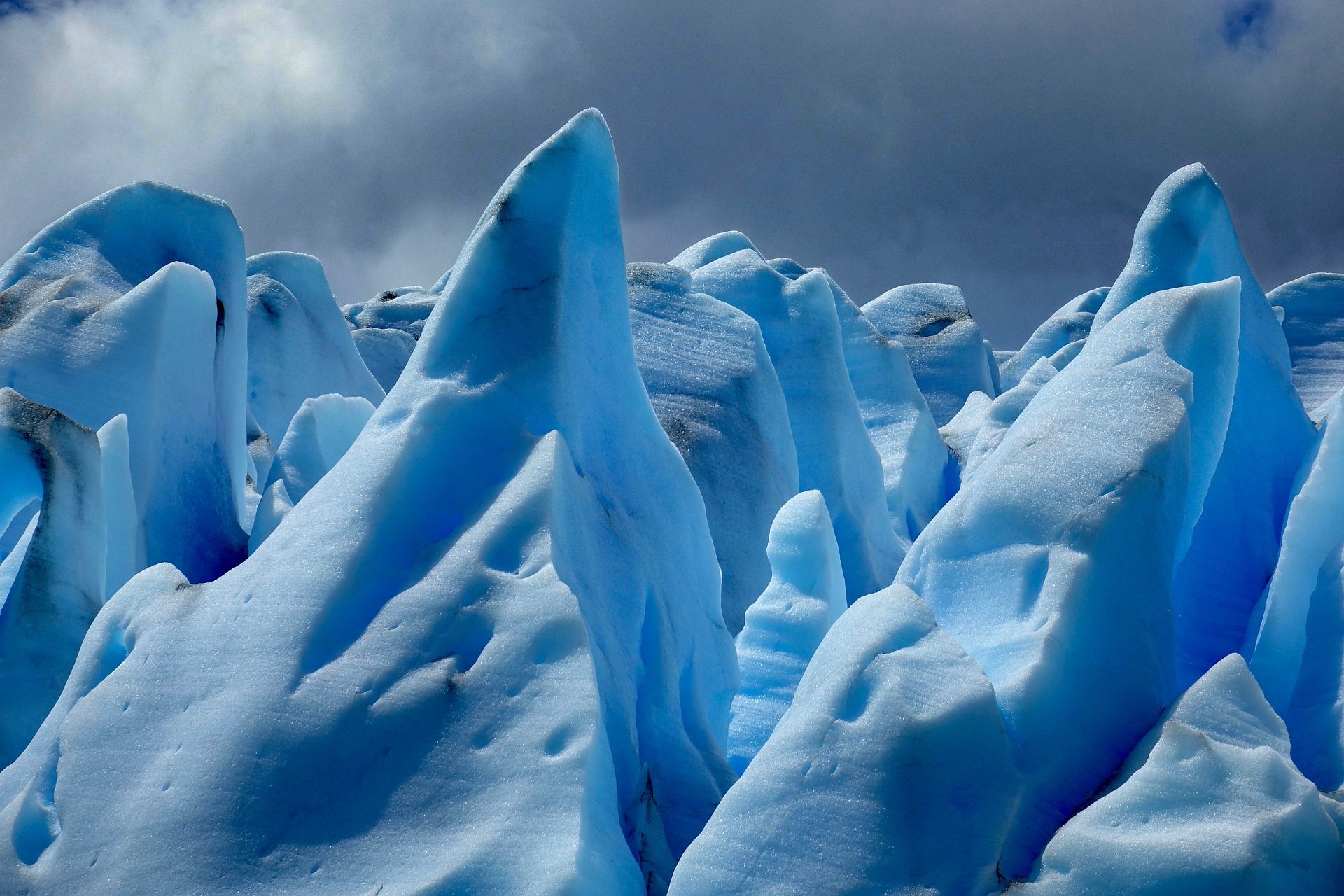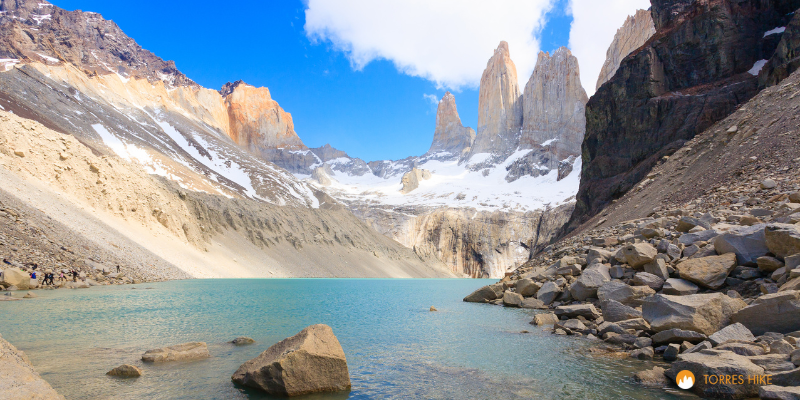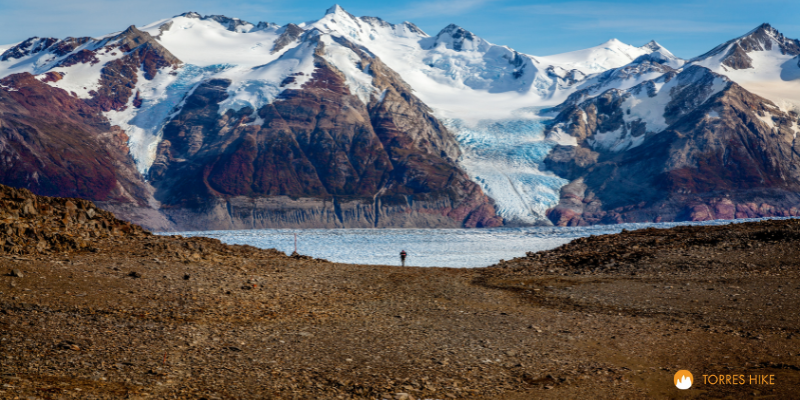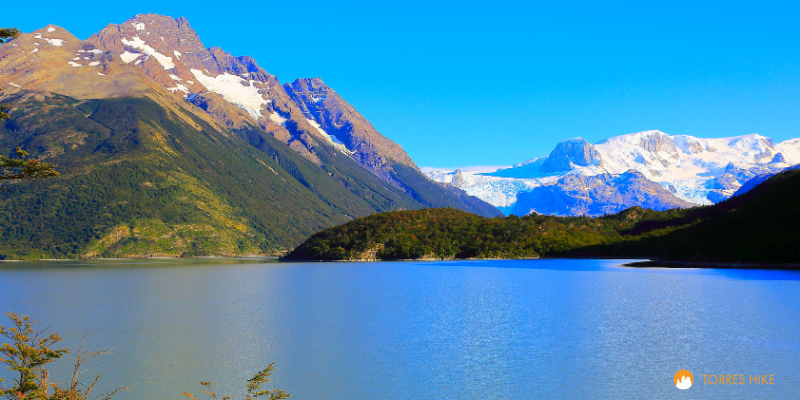The Torres del Paine O Trek, also known as the O Circuit, is a challenging yet rewarding trek that takes you through the Paine Massif. Compared to the more popular W Trek, the O Trek provides a more immersive experience in the park's distant and less-visited parts. W Trek is part of the O Trek, so if you decide to hike the whole circuit, you won't miss any of the Torres del Paine's stunning landscape, including the Base Torres and French Glacier.
The O Trek typically takes 7-8 days to complete and it is closed during the winter season. There are no guides required for this trip; nonetheless, there are guidelines to obey while hiking the O Trek. For instance, to hike the O Trek, you must provide proof of reservations for mandatory campsites.
Table of contents
The O Trek overview
Total distance: 85 miles/136 kilometers
Difficulty: Moderately difficult; some parts are quite challenging.
Total elevation gain: 16 309 feet/4 971 meters
⚠︎ Closed during the winter season (usually from April to October).
Torres del Paine O Circuit map
How to walk the O Trek
The O Trek can be walked only in one direction - counterclockwise.
It allows for a gradual buildup of difficulty, with the challenging John Garner Pass tackled mid-trek rather than at the beginning.
The campsites along the O Trek are relatively close to one another, and you can choose to skip certain campsites if you are short on time. However, some campsites are mandatory to stay at (Serón, Dickson, Los Perros, Grey).
How do I get to the start of the O Trek?
When hiking the O circuit, there are various campsites to spend your first night. The most popular alternative is to spend the first night in Serón or Torres Central & Norte.
Alternatively, you may begin at Chileno, Paine Grande, Francés, or Cuernos.
First night in Serón/Torres Central & Norte/Chileno
If you're staying in Puerto Natales the night before your trek, you can take a direct bus to Torres del Paine the next morning.
- Take the morning bus from Puerto Natales Bus Terminal to Torres del Paine - Laguna Amarga. Tickets can be booked in advance at BusSur.com or directly through TorresHike when making your reservation.
- At Laguna Amarga, all visitors must present their passport, show park entrance tickets, and provide reservation vouchers for camps and refugios.
- Take a shuttle bus to the Welcome Center, which is located just a few steps from Torres Central & Norte.
- Stay at Torres Central, or continue 6 km to Chileno or 14 km to Serón on foot.
First night in Paine Grande/Francés/Cuernos
If you're staying in Puerto Natales the night before your trek, you can take a direct bus to Torres del Paine the next morning.
- Take the morning bus from Puerto Natales Bus Terminal to Torres del Paine - Pudeto. Tickets can be booked in advance at BusSur.com or directly through TorresHike when making your reservation.
- The bus first stops at Laguna Amarga, where all visitors must present their passport, show park entrance tickets, and provide reservation vouchers for camps and refugios. After the check, the bus continues to Pudeto.
- At Pudeto, take the catamaran across Lake Pehoé to reach Paine Grande. We strongly recommend booking your catamaran ticket in advance at catamaranpehoe.com. If you book your accommodation through TorresHike, we can arrange catamaran tickets for you.
- Once you arrive at Paine Grande, you can either stay here for your first night or continue east on foot to Francés or Cuernos.
Read the full guide on how to get to Torres del Paine ⬇️

Skipping campsites on the O Trek
The subject of whether or not it is permitted to skip campsites on the O Trek often occurs. Let’s look at the rules.
CONAF, the official park’s administrator, does not authorize hiking the O Trek while skipping campsites in the northern part of the O Trek.
Additionally, there are trail closure schedules that are designed to keep you from reaching the campsites too late in the day.
This, along with the fact that the northern part of the O Trek is more difficult, is why we require that the O Trek reservation cover all campsites in Torres del Paine's northern section.
These campsites are Serón, Dickson, Los Perros, and Grey - in that order.
You can choose not to stay at every campsite in the southern part of Torres del Paine. These campsites are Paine Grande, Francés, Cuernos, Chileno, and Torres Central & Norte.
O Trek Campsites and Refugios
Camping Serón (Las Torres Patagonia) - opens on November 1st
- Mandatory campsite
- Campsite-only
- Shared bathrooms, hot water showers, designated cooking area, dinning room witch kitchen, bar, food service
- Possible to book a tent with or without sleeping bag or just a camping spot
- Device charging possible during daytime hours
Camping & Refugio Dickson (Vertice Patagonia) - opens on November 1st
- Mandatory campsite
- Check in 1 PM/ Check out 9:30 AM
- Shared bathrooms, hot water showers, food service, designated cooking area, restaurant, mini market, bar
- Possible to rent sleeping bags, sleeping mats and tents
- Device charging possible during daytime hours
- No Wi-Fi
Camping Los Perros (Vertice Patagonia) - opens on November 1st
- Mandatory campsite
- Campsite-only
- Check in 1 PM/ Check out 7:00 AM
- Shared bathrooms, cold water showers, designated cooking area, mini market
- Possible to rent sleeping bags, sleeping mats and tents
- Device charging possible during daytime hours
- No Wi-Fi
Camping & Refugio Grey (Vertice Patagonia) - opens on October 1st
- Mandatory location
- Check in 1 PM/Check out 9:30 AM
- Shared bathrooms, hot water showers, food service, designated cooking area, restaurant, bar, mini market
- Possible to rent sleeping bags, sleeping mats, tents
- Device charging possible during daytime hours
- Wi-Fi available for an extra fee
Camping & Refugio Paine Grande (Vertice Patagonia) - opens on October 1st
- Check in 1 PM/Check out 9:30 AM
- Shared bathrooms, hot water showers, food service, designated cooking area, restaurant, bar, mini market, cafeteria
- Possible to rent sleeping bags, sleeping mats and tents
- Device charging possible during daytime hours
- Wi-Fi available for an extra fee
Camping & Refugio Francés (Las Torres Patagonia) - opens on September 15th
- Shared bathrooms, hot water showers, designated cooking area, restaurant, food service, bar, mini market
- Possible to book a tent with or without sleeping bag or just a camping spot
- Fully made beds at the refugio
- Device charging possible during daytime hours
Camping & Refugio Cuernos (Las Torres Patagonia) - opens on November 1st
- Shared bathrooms, hot water showers, designated cooking area, restaurant, food service, bar, mini market
- Possible to book a tent with or without sleeping bag or just a camping spot
- Fully made beds at the refugio
- Device charging possible during daytime hours
Cuernos Mountain Cabins (Las Torres Patagonia) - opens on November 1st
- Private cabins (maximum capacity 2 people), fully made beds, towels, shared bathrooms, hot water showers, firewood heaters
- Designated cooking area, restaurant, food service, bar, mini market
- Device charging possible during daytime hours
Chileno Camping (Las Torres Patagonia) - opens on October 1st
- Campsite-only
- Shared bathrooms, hot water showers, food service, restaurant, bar, mini market
- Possible to book a tent with or without sleeping bag or just a camping spot
- Due to the high risk of forest fires, the use of stoves in the Chilean Sector is prohibited.
- Device charging possible during daytime hours
Camping & Refugio Central (Las Torres Patagonia) - Camping opens on September 15th, Refugio opens on October 1st
- Shared bathrooms, hot water showers, designated cooking area, restaurant, bar, mini market, food service
- Possible to book a tent with or without sleeping bag or just a camping spot
- Fully made beds at the refugio
- Device charging possible during daytime hours








Campsites and Refugios along the O Trek
O Trek suggested itinerary
From Serón - 8 days/7 nights
This itinerary is one of our favorites. It starts at Serón and finishes at the famous Mirador Las Torres. Since you will be entering and leaving via bus, it will save you the hassle of traveling by catamaran.
Day 1: Serón | ➡ Walking distance: 14 kilometers
🚍︎ Catch a bus from Puerto Natales, departing at 7 AM from the Puerto Natales Bus Terminal.
🛈 Have your documentation checked at the Laguna Amarga park entrance.
🚍︎ Take a shuttle to the Welcome Center.
➡ Continue on foot for approximately 14 kilometers to reach Serón.
Day 2: Dickson | ➡ Walking distance: 18 kilometers
➡ Start trekking from Serón all the way to Lago Paine, where you can admire its turquoise color. Then continue to Refugio & Camping Dickson, where you spend the night.
Day 3: Los Perros | ➡ Walking distance: 11 kilometers
➡ Hike towards Camping Los Perros. This day is neither very long nor difficult, but rest assured, you will appreciate it later. Relax and gather your strength before you hit the trail the next day, which will be the most challenging one.
Day 4: Grey | ➡ Walking distance: 15 kilometers
⚠︎ Start your day early, as you're up for the hardest part of the O Circuit. Prepare yourself for some serious elevation. Today you will pass the highest point at the John Garner Pass.
➡ Enjoy the best views of the Grey Glacier, then descend all the way to Refugio & Campsite Grey. This campsite is also a place where you meet other hikers from the W Trek.
Day 5: Paine Grande | ➡ Walking distance: 11 kilometers
➡ Appreciate a slower day since you will only walk 11 kilometers towards Paine Grande.
Day 6: Francés/Cuernos | ➡ Walking distance: 20-23 kilometers
➡ Start trekking from Paine Grande through the magnificent French Valley all the way up to Mirador Británico.
⚠︎ Keep in mind that the route from Camp Italiano to Mirador Británico is not open all day and if you want to go there, you need to start your hike in the morning. It is better to check the closing time at the park, as it varies.
➡ Return from Mirador Británico and spend the night either at Francés (20 km) or Cuernos (23 km).
Day 7: Torres Central & Norte/Chileno | ➡ Walking distance: 13-17 kilometers
➡ Walk all the way to either Torres Central & Norte or Chileno.
⚠︎ If you want to hike to Mirador las Torres the next morning to catch the sunrise, make your reservation in Chileno.
Day 8: Return to Puerto Natales | ➡ Walking distance: 15-20 kilometers
➡ Hike to the Mirados Las Torres and see the famous Towers del Paine.
➡ Walk to Torres Central & Norte.
🚍︎ Take a shuttle bus to the park entrance.
🚍︎ From the park entrance, take a bus back to Puerto Natales.
🛈 Before finalizing your plans, check the bus schedule online and purchase your tickets on BusSur.com.
How difficult is the O Trek?
The O Trek is considered moderately difficult, with a few challenging parts. You need to take its length, variable weather, and steep ascents and descents into account before you make a decision whether to go or not.
If you have never experienced a multiday hike, we suggest trying the W Trek first. Alternatively, consider booking the 8-day itinerary to avoid unnecessary long distances.
Read more about the W Trek ⬇️

The points of interest along the O trek
The O Circuit is packed with stunning natural landmarks and diverse landscapes. Let’s look at some of the key points of interest.
The Base Torres (Mirador las Torres)
The Base Torres is, without a doubt, a must-see attraction for the majority of hikers. It offers a spectacular view; three distinct peaks of the Towers of Paine standing over a blue glacier lake.
Torre D'Agostini (also known as the South Tower), Torre Central, and Torre Monzino (commonly known as the North Tower) are over 8,200 feet (2,500 meters) tall.

John Garner Pass
John Garner Pass is not for the faint-hearted. It begins at Laguna Los Perros and has a total elevation gain of 830 meters up and 1324 meters down, making it one of the most challenging parts of the trek. However, the views from the top are worth every ounce of effort. Prepare to be blown away by the breathtaking views of the Grey Glacier.

Dickson Glacier
Not far from Dickson Lake, this glacier is a hidden gem of the O Trek. The trail to the glacier offers an incredible opportunity to witness the raw power and beauty of glacial formations up close.

When is the best time to hike the Torres del Paine O circuit?
The question of when to hike the O Circuit can be answered in two ways. It depends on how essential nice weather is to you.
Most people will probably tell you to go during the summer months, which in Chile are December through February. But keep in mind that this is peak season and the park can be crowded. So if you prefer to visit the park during the off-season, make your reservations for March. Another alternative is November, during Patagonian spring. The park is less crowded, but the weather can be unpredictable.
Also, remember that even though the O Circuit is usually open from November to March, CONAF can decide to close the O Trek part of the park a few days earlier, mostly because of bad weather conditions. It has happened before. Consider this possibility before making a reservation for the end of the season.
Additionally, be aware that the John Garner Pass, a critical part of the O Circuit, can be covered in snow, which can theoretically happen even at the beginning or end of the high season. If this occurs, CONAF might close the entire upper part of the trek, making it impossible to complete the O Circuit.
What to pack for the O Trek
Packing for the O Trek takes a bit of thought. The weather in Patagonia changes quickly. You might experience sun, wind, rain, and even snow in a single day.
What you’ll need also depends on whether you’re carrying your own camping gear or staying in refugios with meals and bedding provided.
To make it easier, we’ve put together a printable checklist you can use while preparing for your trek.
Download Torres del Paine packing list ⬇️
Layering is essential for comfort, since the weather may change quickly. Remember to pack light, since too much weight might make your trip more difficult.
Have any questions about the O Trek? Ask away. Have you found this article useful? Share it with others.
